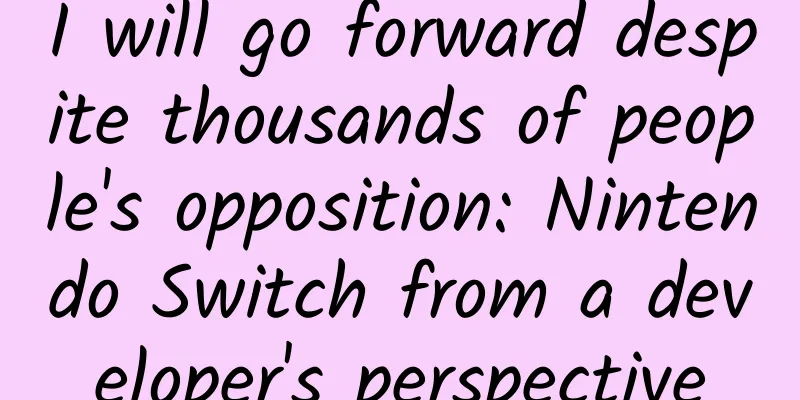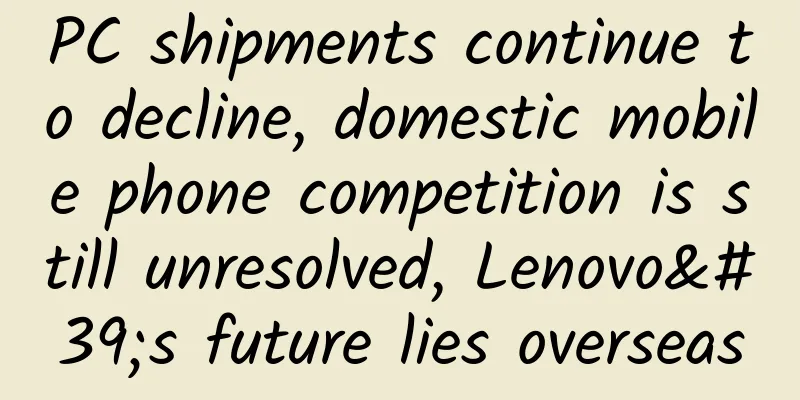I will go forward despite thousands of people's opposition: Nintendo Switch from a developer's perspective

|
Recently, Nintendo announced the much-anticipated mysterious console "NX" and officially named it Switch. Let me put the conclusion first: this is a gamble, the success rate and failure rate are equally high. Let’s start with the failure of Wii U To predict whether this machine will be successful as a product, I would like to start with its predecessor, the Wii U. All of Nintendo's actions on this machine will directly reflect their thinking and attitude towards the previous unsuccessful console, the Wii U. As we all know, the Wii U has performed very poorly in the market and is almost forgotten. I think there are two fundamental reasons for this: one is its hardware design itself, and the other is its marketing strategy. Before SEGA withdrew from the hardware market, the advantages and disadvantages of the major consoles, that is, the differences, were very obvious, and game developers also developed games based on the prototype development machines provided by the console manufacturers. Developers got the prototypes, and with the support of the console manufacturers, they understood them, used them, and played them. However, today, games have higher and higher requirements for team members, and the engines are becoming more and more complex and profound. The long development cycle has made most development teams no longer wait for the prototypes of the next-generation consoles, but develop the next-generation games on the PC platform first. When the new consoles come out, they will try to "port" the games to the consoles. This is why there are more and more cross-platform games-because the initial development platforms are actually the same. This is also why the graphics of The Witcher 3's demonstration are so good, but they will shrink on the console-because when developing, the team didn't even know the true performance of PS4 and Xbox One. Then, "transplanting" from PC means that the closer the host environment is to PC, the easier this work will be. The easier it is, the lower the cost, and the more motivated developers are to increase user enthusiasm through this practice. Both PS4 and Xbox One use the same x86 structure as PC, but Wii U does not. Coupled with the relatively weak performance of Wii U, it is too difficult for third parties to "transfer" pre-developed games to Nintendo's platform. Coupled with the hardware peculiarities of Wii U, it is not easy for developers to come up with creative and original ideas, and the result is known to everyone - "Three Graves" (Editor's Note: "Third-Party Graveyard"). Buying a console is equivalent to rejecting too many games you like: "The Witcher 3", "Metal Gear Solid 5", "Assassin's Creed" series... For core players, the choice of whether to buy or not is not difficult to make. The Wii U was once highly anticipated The second reason is the marketing strategy. This point was raised by Nintendo's new CEO, Tatsumi Kimishima. Perhaps it is because bystanders see more clearly. Tatsumi Kimishima, who has a background in finance, mentioned that for ordinary people, Wii U and Wii are too similar. From naming to appearance to games to global marketing, people feel that Wii U is a contemporary product of Wii. Don't forget that when Wii swept the world, many Wii players were newly added light users. Their understanding and persistence of games are at a marginal state, and they are not very likely to actively update their understanding of the game market. So what is the difference between Wii U and Wii, and whether they should buy more games to experience it, they are not so enthusiastic. These light users are tired of the physical sensation and lack the stimulation of "new hardware", so they no longer buy it. Compared with Wii, the sales of Wii U naturally come and go like the tide. This is a huge mistake Nintendo made in creating "user perception" through marketing. Reflecting on the performance of Wii U, when we look at the highly anticipated "Switch" launched by Nintendo, I believe we will have a reasonable perspective: Nintendo does not completely deny the design concept of Wii U, but tends to "inherit". Can the boundary between handheld and console really be broken? Before the announcement, there were rumors that "NX" was a hybrid of a handheld game console and a console. When playing at home, you can enjoy the good graphics of the console; when taking it out, you can enjoy its portability. This is actually the most ideal situation, but this requires the console to have two computing systems, a powerful one for home use and a low-power one for outdoor use. It is similar to running the same PC game on two computers with different configurations, one with full special effects and anti-aliasing, and the other with medium and low special effects. This idea is not impossible, because for current 3A masterpieces, a large part of the hardware performance is used to calculate the display part, that is, the visual effect. After reducing the visual effects on the screen, the requirements for console performance for calculating a 3A masterpiece are not that high. The problem is only the cost. Two computing systems mean that the cost is too high, and players have a psychological bottom line for the price of the console. If the price exceeds this, they will be directly retaliated by the market. Nintendo will not repeat the mistakes made by PS3. Is it a handheld or a console? After the announcement, we can find that Switch has only one computing system, all in the main body with a built-in screen. After taking out the main body, what is left is just a pure base, which is responsible for decoding games and audio and outputting them to large screens such as TVs and projectors through the HDMI port. This has also led to many people in the industry, such as some game media personnel, to make some praises. The most typical view is that Nintendo has broken the boundaries between consoles and handhelds, making game consoles pure, making games simpler, and playable anytime, anywhere. And this is what I disagree with and oppose the most. I just mentioned that Wii U made a big mistake in terms of player perception. If Switch really makes users think that it is both a console and a handheld, breaking the boundary between the two, then this will be its second mistake. This kind of user perception is harmful and has no benefits. First of all, it is questionable whether the boundary between consoles and handhelds can be broken. When Final Fantasy 15's producer Tabata Hajime came to Shanghai to participate in an event, he once raised a question, that is, how should traditional console games respond to the impact of smart mobile terminals represented by iPad/iPhone. The answer he found was "immersive experience", using top-level pictures, music, and scripts to combine into top-level stories, and achieve top-level experience to divide the categories with smart mobile terminal games. My personal understanding is equivalent to the difference between TV series and movies. It doesn't look obvious, but it's actually very big. Let's take the "God of War" series, which has shocked countless players and can be said to be a heavy experience, as an example: I believe that many players are full of praise for Kratos' experience of fighting huge enemies in grand scenes. From the developer's perspective, one of the keywords of the game can be described as "grand". So, what is "grand". As an adjective, big and small are always relative. When we play God of War, every time we marvel at "magnificent", we are actually exclaiming with reference to Kratos' own size in the excellent lens. The size of the scene and the size of the enemies are all based on the "normal size" that can clearly identify Kratos. Kratos in the console Then, if you move it to a mobile phone or tablet, this comparison is difficult to hold. No matter how big the monster is, it can only fill the entire screen. Even if you can barely recognize the small and blurry Kratos on the screen, it is probably difficult to give people a sense of "grandness". If you remove the multi-channel music and sound effects, then I would say that at least half of the atmosphere and appeal of God of War is lost, right? This is the charm of the console, which is a charm that small-screen devices cannot replace. It does not mean that you can appear on both the console and the handheld at the same time just because you "actively break the boundaries". You can't break it. Furthermore, "both a console and a handheld" will only lead to one result, which is "neither a console nor a handheld", and casual users can't figure out what you are. Core players who are keen on the "immersive experience" of console games have their own requirements for picture improvement. Judging from the promotional video and hardware knowledge, Switch is likely to fail to achieve it. Even if you solve the third-party platform, you will be the worst performer of the same masterpiece on three platforms. For handheld gamers, the portability and battery life of Switch are very worrying. Because there is only one set of computing systems, the strength of the chip cannot be low to achieve games close to the console screen. The chip strength is naturally proportional to power consumption. So I think the screen of Switch, which is much larger than that of ordinary handhelds, is only for picture performance on one hand, and more importantly, it allows more space under the screen to dissipate heat and place the battery. With a large battery, plus the chip and motherboard, the "portable game part" of Switch is basically certain to be heavier than the Wii U controller. The weight of the Wii U controller has been criticized for being too heavy. For casual players, in order to beat the games on their smart mobile devices and get them to buy an extra device, you must provide a gaming experience that is absolutely unavailable anywhere else. An audio-visual and picture experience close to that of a console is actually a very good way, but a good operating experience of a controller is not. What is the difference between a Switch and an iPad + Bluetooth controller? The Switch's hardware architecture is optimized specifically for running games, and can run large games such as the latest "Zelda" more efficiently. The reason is that the controller design is based on player habits rather than matching the iPad, and the two are seamlessly integrated. Making users realize this is the key to Nintendo's success or failure. In short, "this is a portable console" must be conveyed to users, traditional hardcore players, and third-party game developers, so that they can unify their understanding. "Switch" is the keyword. Switching is just switching between indoor and outdoor, not switching between consoles and handhelds, not switching between mainframes and mobile devices. Narrowing down the concept and purifying the concept are the key points for Nintendo to avoid missing the positioning in this Jedi counterattack. At present, my understanding is that Nintendo is aware of this. Let's look at some details. The trailer does not explain whether the screen is touchable. I personally think this is not important. The emphasis on whether it is touchable is still based on the previous generation of handheld game consoles such as 3DS and mobile devices such as iPad. The real comparison is of course home consoles. If it is touchable, how can you "touch" it when connected to the TV at home? It adds unnecessary variables. Whether it supports touch screen remains a mystery The carrier of the game is still the cartridge. There is no problem with this. The reading speed and carrying capacity of the cartridge are only advantages rather than disadvantages compared to the Blu-ray disc. The cost is slightly higher, but it is not a decisive factor. As for the hard disk capacity and memory of the host itself, they are more critical. Both PS4 and Xbox One start at 500G. It seems difficult for Switch to do this at the moment. Use flash memory instead of hard disk? - It will greatly increase the cost. For the gaming experience, many third-party games, especially some games with seamless large maps, will encourage players to install some game files locally. If Switch cannot do this, it will cause trouble for third parties. I emphasize again: its comparison object must be the host, not handheld game consoles and iPads. In the promotional video, we can find two more details. One is that the handsome guy on the plane can use the detached controller to perform operations similar to the Wii chicken legs, which means that the previous games can be inherited in the form of digital versions. The other is the appearance of the Pro controller that Nintendo has traditionally had in every generation of consoles. This device is very similar to the style of the PS4 and Xbox One controllers, allowing players to fully enter the role of "hardcore" players to play heavy games such as FPS and ACT, which also complements the new "Splatoon" game announced at the end of the film. Developer challenges and social issues Finally, I want to mention two more points that I disagree with. One is still "Switch blurs the boundaries between consoles and handhelds. As a new device, it liberates developers, allowing them to no longer fight on two fronts, consoles and handhelds, and focus on making the game fun." This argument is nonsense. This two-front battle has never existed. Developers have already positioned users and hardware platforms from the beginning. If there are two platforms, then there are two teams or groups. This is not at all analogous to the dual versions of iOS and Android. The Elder Scrolls 5 is not yet installed Another one is very important. It can be seen from the promotional video that Nintendo still encourages face-to-face online social interaction. The key to this issue is not whether the things you pursue are good or not, but whether you can do it. In the era of FC, we had few choices, and even fewer game choices. Two people played on one machine and five people watched. That kind of social interaction was endless fun. However, face-to-face social interaction, or real social interaction, is definitely not the mainstream nowadays. The pace is fast, everyone is busy, and indirect communication through social software and asynchronous interaction through messages and likes have become the living habits of many people. Although you hope that when playing "Battlefield" and COD, it is better to communicate with your comrades in the game by your side, but it is not impossible to communicate through a microphone, right? Or you don't really care whether your teammates are human or dog. Real social interaction requires more time and physical costs. On a lazy afternoon, you have to get up from bed and go outside, and take public transportation to play Switch with your friends. After finally arriving, you find that two of the four people you agreed to meet with are missing. One has to work overtime, and the other is called away by the instructor. Will the fun be reduced? Meeting in person is wonderful, but it seems too difficult. Switch inherits the multiplayer function of Wii U, and perhaps it will happen more often within the family. Speaking of inheritance, the original concept of Wii U was to be a console that could get rid of the constraints of TV and liberate space. Today, Switch still emphasizes a lot of outdoor use, and uses the calculation under the screen to completely get rid of the constraints of TV, further liberating space. The concept of multiplayer fun is Nintendo's tradition, and it has also been inherited. Although facing challenges, Nintendo has finally come up with something different in this era when there has been no major innovation in IT hardware in the consumer market for a full 10 years. Still rejecting the X86 architecture that is beneficial to third parties, still tirelessly encouraging players to have real face-to-face social fun, and even taking the risk of adopting the most cutting-edge mobile chips in N cards, all of this expresses the strong momentum of this old factory facing the impetuous market, "even if there are thousands of people, I will go." Follow the mainstream? No, Nintendo is the pioneer of trends. "This is a portable console", this kind of strong concept innovation is enough. Which consoles of all generations can get rid of TV, which can be connected to each other, and which can be taken on the plane? That's enough, accurately market this concept and let traditional console players accept it. It is a good choice for students who dislike the trouble of moving and have limited space, and tenants who have just started working. Those light users can also use it to get in touch with some powerful console games, those games that you can never see on your mobile phone, and feel more fun. I believe that Nintendo will support and satisfy the audio and video and online browsing you want in the future. Once this is not done, it will make people feel that it is a "multimedia device that can play games" and "a handheld game console with a picture as good as a console", then it is very likely to fail. Once the novelty is over, the subsequent hardware and software sales will be weak again across the board. Let's wait and see how Nintendo goes its own way. As a winner of Toutiao's Qingyun Plan and Baijiahao's Bai+ Plan, the 2019 Baidu Digital Author of the Year, the Baijiahao's Most Popular Author in the Technology Field, the 2019 Sogou Technology and Culture Author, and the 2021 Baijiahao Quarterly Influential Creator, he has won many awards, including the 2013 Sohu Best Industry Media Person, the 2015 China New Media Entrepreneurship Competition Beijing Third Place, the 2015 Guangmang Experience Award, the 2015 China New Media Entrepreneurship Competition Finals Third Place, and the 2018 Baidu Dynamic Annual Powerful Celebrity. |
<<: Model S adds a new all-glass transparent sunroof for just 10,000 yuan
>>: What are the dangers when talking about autonomous driving cybersecurity?
Recommend
WeChat registration covers 30 provinces and cities across the country, 640 hospitals without queuing
[[283645]] What do you fear the most when going t...
Case review | Marketing strategy, execution and highlights of NetEase Yanxuan’s 411 anniversary event
When we talk about a company, it is no longer abo...
The future of virtual reality: multi-sensory interaction technology
Virtual reality provides us with a virtual world ...
Facebook launches new video embed API and Apple Watch/TV SDK
Facebook has already provided a lot of useful too...
The different concepts of positions in RecyclerView can help you handle data items and user interactions more efficiently.
getAdapterPosition getAdapterPosition() is a meth...
Dear advertiser, what misunderstanding do you have about advertising creativity?
A few days ago, a colleague sent me an App screen...
Should B2B companies create video accounts and live broadcasts?
“Should we also do video accounts and live broadc...
Original camera selfie challenge: Apple, Huawei, Samsung, who is better?
We have ushered in an era of selfie fever, and pe...
What is the difference between a programmer and an engineer?
[[152894]] When I first started working, the inte...
Summary of the use of global variables and local variables in Android
As the name implies, global variables are variabl...
New energy stocks will be released by the end of July to allow foreign investment
On June 28, 2018, China's Ministry of Commerc...
Shandong, “half of it is on the sea”!
What color do you think of when you mention Shand...
The sun is smiling strangely, what does this indicate?
Have you ever seen the sun smile? Here is a photo...
From King of Glory, I summarized the three major operating magic weapons of Tencent Games
Two things happened recently. First, more than ha...
China's chip manufacturing has taken a big step forward! The Chinese Academy of Sciences has built the most powerful ultraviolet super-resolution lithography machine
[[251267]] my country has made new breakthroughs ...









